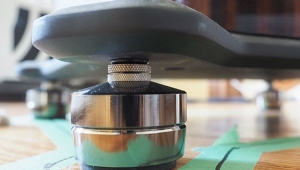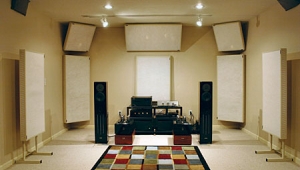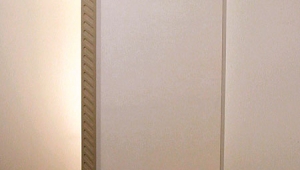| Columns Retired Columns & Blogs |
TacT Audio RCS 2.0 digital equalizer/preamplifier Page 4
Hoary old platitudes
The walls melted away. I was transported to the performance. The speakers disappeared. A veil was lifted. Yadda yadda yadda.
The walls melted away. I was transported to the performance. The speakers disappeared. A veil was lifted. Yadda yadda yadda.
Well, excuse me! These clichés accurately describe the RCS's removal of my listening room's superimposed character. It permitted me to hear the low-level ambience cues of the original performance sites. This information was already on the recordings, but now I was simply hearing more of it, and better. The rain during Ivor Humphreys' flute solo on an old Hi-Fi News & Record Review test CD, and the various activities, acoustic and mechanical, on the Cowboy Junkies' The Trinity Session (RCA PD88568), were not just undeniable, but were intrinsic to the re-creations of the events. Switching back and forth, I never found Bypass to sound bad, but I always found the corrected sound preferable—often by a small margin, but just as often by a large one.
My favorite? Sera Una Noche, a marvelous tango disc from M•A Recordings (M052A), which I've been using as a reference disc since January—warm, wonderful, dynamic music recorded with great clarity in a very large space (though not the one pictured on the cover). But I didn't know how great that clarity was until I switched in the RCS. On track 6, "Nublado," the deep, velvety clarinet and bandoneon balanced the crisp percussion and guitar. The RCS brought me into a believable space in which each instrument had a presence and a place.
Is it really that good?
To hear just how far the capabilities of the RCS might extend, I performed two more tests. First, I removed all acoustic treatments from the room and aimed my Revel Ultima Studio loudspeakers straight ahead, to eliminate their usual toe-in. CARA predicted that this would make the midbass less regular and would magnify the differences between the channels. The TacT's measurements and my ears concurred: The system definitely sounded lumpy and had more glare.
I quickly performed a new set of measurements and corrections and, lo and behold, all was well again. Perhaps the new arrangement had a bit less palpable center-fill, but it was otherwise excellent. I still prefer the sound with the Studios toed-in, but I don't know when, if ever, those damping/absorption panels will be back.
The second test involved plopping an unfamiliar pair of dipole speakers down in the listening room with little care taken in their placement. I was trying to emulate the situation, described by Peter Lyngdorf, in which a consumer's new system arrangement is dictated by domestic considerations in defiance of proper setup. Without removing the Ultima Studios, I put the new left speaker about 4" from the cabinets, and the right one where it was slightly blocked by an upholstered sofa. The left channel had a tipped-up mid and treble and a reasonably extended but very bumpy bass. The right-channel bass had a 10dB hump, and the response curve tilted down from 2kHz at about 6dB/octave! Together, they sounded bad.
I then invoked the magical healing powers of the RCS and—would you believe it?—the new speakers sounded decent. Not great, and not as good as I think these speakers can sound, but definitely listenable. (To protect the innocent, the speaker's identity shall not be revealed.)
Can I be TacTless?
Now, as I send off review sample and review, I still love my system, however TacTless. I can live without the RCS—just not as happily. There's no question that room correction, used with some care and effort, can improve a system in ways that little else can. While the improvement may not be as gross as when changing speakers, it is more significant: the RCS's enhancement is applicable to all equipment and sources. True, it costs more than careful room arrangement, more than room modeling and analysis software, and more than most acoustical treatments. But, unlike the RCS, none of those can ameliorate significantly the effects of room dimensions and other domestically imposed constraints. The real question is, why would I want to live without the TacT RCS?
The two biggest enemies of achieving satisfaction with the TacT are a lack of perseverance and one's own comfortable biases. Achieving the ideal correction requires continual re-evaluation and listening over a period of weeks or months, and, without independent measurements, it could be difficult to determine which correction is right.
It's natural to try those recordings which you already know sound good in your system; if your standard is the familiar sound of these recordings in your system, the RCS will, by definition, fail. Therefore, you must continually reassess your own criteria by listening to the sound of live music in real spaces.
The longer I lived with the TacT Audio RCS 2.0, the more I was convinced that it brought me much closer to the sound of live music, and that room correction should be a mandatory part of any serious audio system. In the future, it will be.
- Log in or register to post comments































